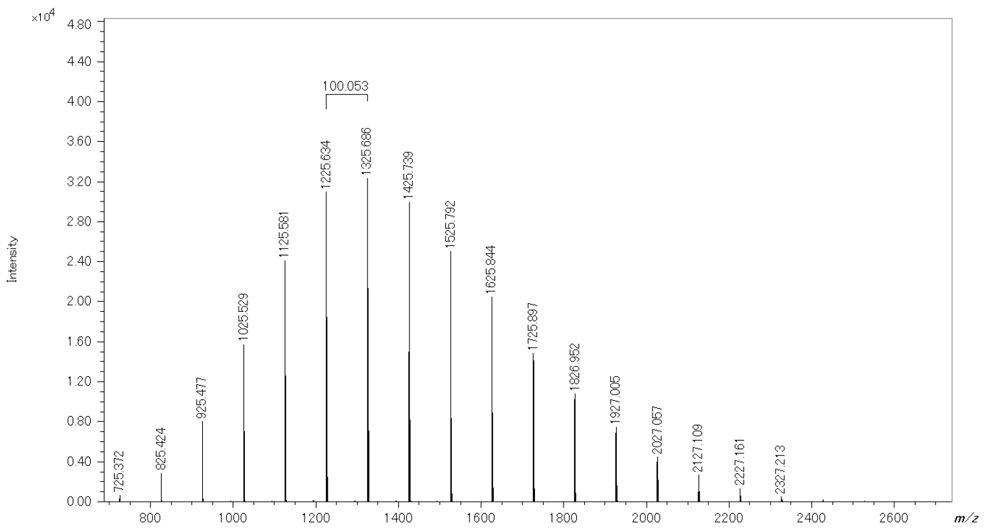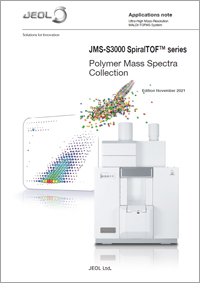JMS-S3000 SpiralTOF™ series Polymer Mass Spectra Collection
November 2021 edition
This booklet is a collection of polymer mass spectra acquired by using JMS-S3000 SpiralTOF™-plus matrix-assisted laser desorption / ionization time-of-flight mass spectrometers (MALDI-TOFMS).
Please refer the legend on page iii regarding the information attached to each mass spectrum.
Note that none of the mass spectra in this booklet shows a guaranteed performance specification of the mass spectrometer.
- Please see the PDF file for the additional information.
Another window opens when you click. 
PDF 4.27MB
Table of Contents
Legend iii
SpiralTOF Mode P1~
- PEO (poly(ethylene oxide)) MW 2000
- PEO (poly(ethylene oxide)) MW 6000
- PPO (poly(propylene oxide))
- PPO Triol (tris(polypropylene oxide) glyceryl ether)
- PMMA (poly(methyl methacrylate))
- PMMA (poly(methyl methacrylate))
- PS (poly(styrene)) MW 1000
- PS (poly(styrene)) MW 10000
- PMHS (poly(methylhydrosiloxane))
- PDMS (poly(dimethylsiloxane))
- Nylon 6 (polycaprolactam; poly(hexano-6-lactam))
- PET (poly(ethylene terephthalate)
- PBT (poly(butylene terephthalate))
- PCL (poly(caprolactone))
- PC (polycarbonate)
- PSF (polysulfone)
- PVAc (polyvinyl acetate; poly(ethenyl ethanoate))
- PPA (polyacrylamide; poly(2-propenamide))
- PVA (poly(vinyl alcohol))
- Polyethylene glycol monododecyl ether
- Polyethylene glycol monocetyl ether
- Polyethylene glycol monooleyl ether
- ADK STAB LA-68
- ADK STAB LA-63P
- Polyethylene glycol sulfate
- Polyoxyethylene alkyl ether sulfuric acid
- Poly(alanine)
- Poly(ethylene glycol)-block-poly(propylene glycol)-block-poly(ethylene glycol)
- Poly(ethylene glycol-ran-propylene glycol)
- Poly(propylene glycol)-block-poly(ethylene glycol)-block-poly(propylene glycol)
Linear Mode P37~
- PMMA (poly(methyl methacrylate)) MW 10 kDa
- PMMA (poly(methyl methacrylate)) MW 50 kDa
- PS (poly(styrene)) MW 100 kDa
- PS (poly(styrene)) MW 200 kDa
- POZ (poly(2-ethyl-2-oxazoline)) MW 10 kDa
TOF-TOF Mode P45~
- PEO (poly(ethylene oxide))
- Polyethylene glycol monododecyl ether
- Polyethylene glycol monocetyl ether
- PMMA (poly(methyl methacrylate))
- PPO (poly(propylene oxide))
- PS (poly(styrene))
- Polyoxyethylene alkyl ether sulfuric acid
Index P61~
Abbreviations
| Abbreviation | Description |
|---|---|
| DCTB | trans-2-[3-(4-tert-Butylphenyl)-2-methyl-2-propenylidene] malononitrile |
| CHCA | α-cyano-4-hydroxy cinnamic acid |
| DHB | 2,5-Dihydroxybenzoic Acid |
| HABA | 2-(4-Hydroxyphenylazo)benzoic acid |
| THAP | 2′,4′,6′-Trihydroxyacetophenone monohydrate |
| NaTFA | Sodium trifluoroacetate |
| AgTFA | Silver trifluoroacetate |
Legend
PMMA (poly(methyl methacrylate))

| Structure | H[CH2C(CH3)(CO2CH3)]nH; H(C5H8O)nH | Two formulae, one showing structural information and the other showing elemental composition(s) of the repeating unit(s). If the end groups are unknown, the formula is shown as, for example: -(C5H8O)n- |
| Ion Species | [M+Na]+ | Detected ion species |
| Molecular weight Information | Mn 1498; Mw 1559; D 1.041 | Molar mass information calculated from the observed mass spectrum, NOT the values declared by the manufacturer. |
| Matrix | DCTB | Matrix used for the measurement |
| Cationization agent | NaTFA | Cationization agent used for the measurement |
| Mode | SpiralTOF:Positive ion | Mass analyzer mode and polarity of ions detected |
KMD (Kendrick Mass Defect) plots generated by the msRepeatFinder software are shown for the polymers other than homopolymers with only one kind of end groups.
KM (Remainder of Kendrick Mass) plots generated by the msRepeatFinder software and estimated product ion structures are shown for TOF-TOF (tandem MS) product ion mass spectra.
Related Products
Are you a medical professional or personnel engaged in medical care?
No
Please be reminded that these pages are not intended to provide the general public with information about the products.

